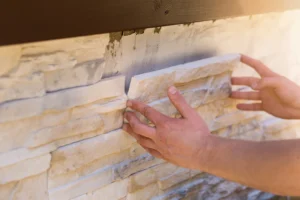Exploring Innovative Stone Exterior Cladding and Alternatives
 In the realm of architecture and design, the search for innovative exterior cladding alternatives continually evolves. Let’s delve into the latest advancements in this field, which includes stone veneer and others while examining distinct categories reshaping building exteriors.
In the realm of architecture and design, the search for innovative exterior cladding alternatives continually evolves. Let’s delve into the latest advancements in this field, which includes stone veneer and others while examining distinct categories reshaping building exteriors.
Stone Veneer Cladding:
Stone veneer, a thin layer of natural or manufactured stone applied to buildings’ exterior or interior surfaces, is designed to replicate the look and feel of traditional full-depth stone with a fraction of the weight and cost. Typically made from limestone, sandstone, slate, or granite, it offers various shapes and sizes to suit architectural styles and preferences.
Differentiating Natural Stone Veneer and Cultured Stone:
While both options offer similar aesthetic benefits, they have key differences:
- Natural stone veneer preserves each stone’s unique characteristics, offering an authentic look that manufactured alternatives cannot replicate.
- Cultured (manufactured) stone, made from a mixture of cementitious materials molded and colored to resemble natural stones, offers greater consistency in color and shape, along with affordability and ease of installation.
Thickness of Stone Veneer:

Stone veneer typically ranges from ¼ inch to 1½ inches thick, allowing easier installation than full-depth stone while maintaining desired aesthetic appeal and durability against time and weather conditions.
Alternatives to Stone Veneer Cladding:
- Porcelain Cladding:
- Cost-effective compared to traditional stone, with customizable looks and textures.
- Low maintenance, resistant to water absorption, mold, and mildew.
- Exceptionally durable against scratches, stains, and extreme temperatures.
- Lightweight and easy to install, ideal for interior and exterior applications like facades and feature walls.
- Faux Stone Cladding:
- Cost-effective and visually appealing, mimicking natural stone remarkably well.
- More affordable and lighter than authentic stone veneer, with similar visual appeal.
- Made from durable materials, resistant to weathering, fading, pests, and moisture.
- Versatile applications for interior and exterior design projects.
- Vinyl Siding:
- Affordable and low-maintenance, offering diverse styles and ease of installation.
- Minimal upkeep, resistant to moisture, rot, and insects.
- Wide range of colors, styles, and textures to match architectural designs.
- Lightweight and easy to install, reducing labor costs and time compared to stone veneer.
Conclusion:
While traditional stone veneer cladding remains popular, exciting alternatives like porcelain cladding, faux stone cladding, and vinyl siding offer new possibilities and practical solutions for modern architectural projects. Each alternative brings its unique advantages, providing architects and designers with a broader palette to realize their creative visions.
Interested in learning more about Stone Exterior Cladding Options? Schedule a lunch and learn with us by contacting us!
